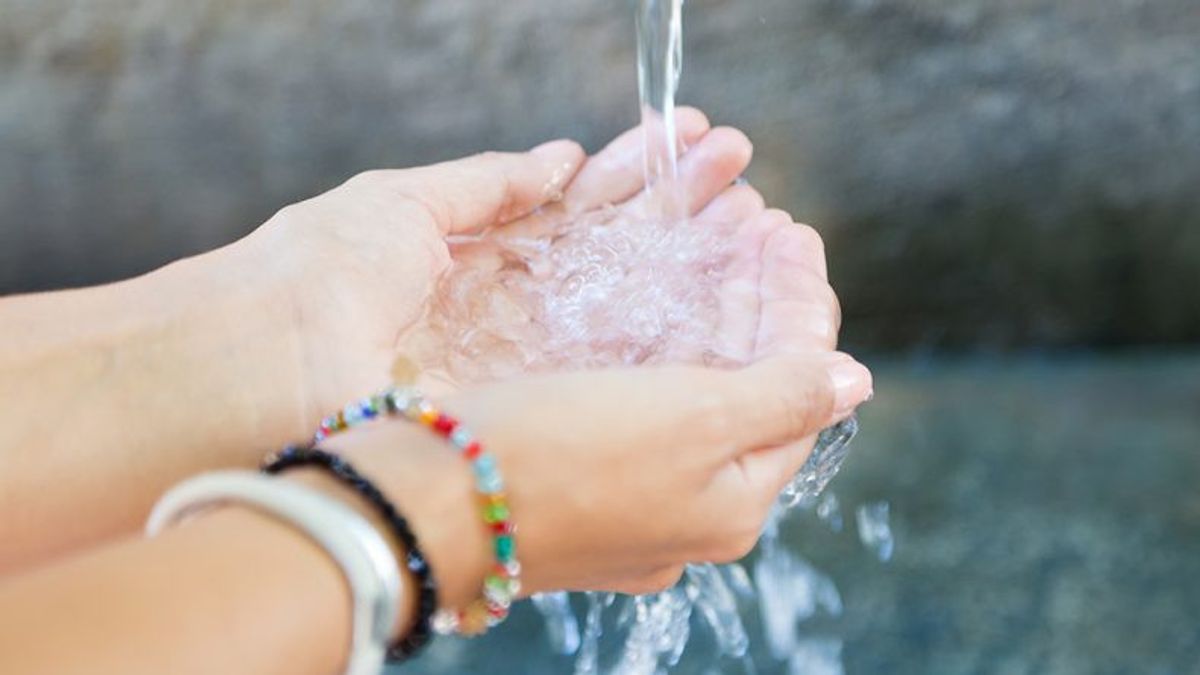JAKARTA - Chemical requirements of clean water must be known, considering that water is a basic human need for daily life. Starting from drinking, bathing, cooking, washing, and so on.
However, water is also a source and medium for producing various diseases, such as diarrhea, cholera, dysentery, hepatitis A, typhus, and worms.
The role of water in the occurrence of the above diseases can be various, such as water as a cause of pathogenic microbes, a nest of insects (insects) that spread disease, and as a temporary nest for the disease.
Unavailability of clean water coupled with a dirty environment can cause disease which later becomes an epidemic. One example is the cholera disease that plagued Batavia (now Jakarta) in the 19th century.
According to Usman Manor in his thesis at the Faculty of Culture Studies of the University of Indonesia, History Study Program, entitled Cholera Outbreak in Batavia 1901-1927 (2015: 33), the cholera epidemic arose because of the dirty city environment and poor sanitation.
Usman said, in the early 19th century, most houses in Batavia did not have latrines or bathrooms. This condition causes the quality of groundwater and canals in Batavia to decline and cholera arises.
Therefore, it is important to know the requirements for clean water in order to avoid various health problems.
Chemical requirements of clean water
According to the Regulation of the Minister of Health (Permenkes) RI No.32/2017 concerning Environmental Health Quality Standards and Water Requirements, the chemical requirements of clean water vary depending on their needs, including:
1. for hygiene and sanitation
Water for sanitation hygiene is the water of a certain quality that can be used for daily needs and the quality is different from that of drinking water.

Photo by Jong Marshes on Unsplash
The maximum chemical requirements for clean water are as follows:
- pH or degree of acidity: 6.5-8.5
- Iron: 1 mg/l
- Fluoride, 1.5 mg/l
- Hardness (calcium carbonate): 500 mg/l
- Manganese: 0.5 mg/l
- Nitrate: 10 mg/l
- Nitrite: 1 mg/l
- Cyanide: 0.1 mg/l
- Detergent: 0.05 mg/l
- Total pesticides: 0.1 mg/l
2. For the swimming pool
A swimming pool is a place and public facility in the form of pool construction filled with treated water and equipped with comfort and safety facilities both located inside and outside the building used for swimming, recreation, or other sports.
Water chemical parameters for swimming pools are:
- pH: 7-7.8
- Alkalinity: 80-200 mg/l
- Residual free chlorine: 1-1.5 mg/l for roofed/uncovered pools and 2-3 mg/l for indoor hot pools
- Remaining bound chlorine: 3 mg/l
- Total bromine: 2-2.5 for an ordinary pool, and 4-5 mg/l for a heated pool
- Residual bromine: 3-4 mg/l
3. For SPA
Solus per aqua or SPA is a water facility that can be used for therapy with certain characteristics whose quality can be obtained by processing or naturally.
The chemical parameters are as follows:
- pH: 7.2-7.8
- Alkalinity: 80-200 mg/l
- Residual free chlorine: minimum 1 mg/l for ordinary SPA and 2-3 mg/l for hot SPA.
- Remaining bound chlorine: minimum 3 mg/l
- Oxidation-Reduction Potential (ORP): minimum 720 millivolts, measured by silver chloride electrode, and minimum 680 millivolts, measured with silver calomel electrode.
4. For public baths
Public baths are public places and facilities using unprocessed natural water which are used for bathing, relaxation, recreation, or sports, and are equipped with other facilities.
For the chemical requirements of the water, namely:
- pH: 5-9
- Dissolved oxygen: more than 4 mg/l
5. For drinking water
According to Regulation of the Minister of Health No.492/2010 concerning Drinking Water Quality Requirements, what is meant by drinking water is water that is processed or without processing that meets health requirements and can be drunk directly.
The regulation states that drinking water is safe for health if it meets the requirements of physics, microbiology, and chemistry.
- Physical requirements
The physical requirements for drinking water are requirements that can be fulfilled by our senses, both sight, smell, and taste.
For the first physical condition, it is clear or not cloudy. Turbid water is caused by colloidal grains from the ground. So, the cloudier the water, the higher the colloid content in it.

Photo by Manki Kim on Unsplash
The second requirement is clear and colorless. Colored water may contain substances that are harmful to health.
The third requirement is to have a bland taste. Physically, water can be felt by our tongue. If the water that is consumed tastes fresh, then the water is good for consumption.
Water that tastes salty will likely contain high amounts of salt. Meanwhile, water that tastes sour is suspected of containing organic and inorganic acids.
Other physical requirements that must be met are odorless, have a normal temperature between 20-30 degrees Celsius, and do not contain solids.
- Chemical requirements
Chemical requirements for drinking water are requirements concerning the levels or content of chemical substances in water. Especially for drinking water, water must not contain substances that can interfere with human health, such as lead (Pb), because tin is very poisonous. Therefore, you are not recommended to use tin pipes.
In addition, another chemical requirement that must be met is pH. Good drinking water, the degree of acidity is in the range of 6.5-9.2. If the pH value is less than 6.5 or exceeding 9.5, it can cause several chemical compounds that are harmful to health.
- Microbiology requirements
The last requirement of good drinking water is that it must meet biological parameters. This requirement concerns the content of microorganisms or microorganisms in drinking water.
The first microbiological parameter is the number of germs contained in 1 cc of drinking water must be less than 100 germs.
Second, in 100 cc of drinking water should not contain Escherichia coli bacteria because it can be harmful to the digestive tract.
Third, drinking water must not contain pathogenic bacteria. Because, it can cause cholera, typhus, dysentery, and gastroenteritis (disorders of the stomach).
Among the three requirements, the physical requirement for drinking water is the easiest to recognize. Therefore, at least the water consumed must pass these three parameters.
The English, Chinese, Japanese, Arabic, and French versions are automatically generated by the AI. So there may still be inaccuracies in translating, please always see Indonesian as our main language. (system supported by DigitalSiber.id)













